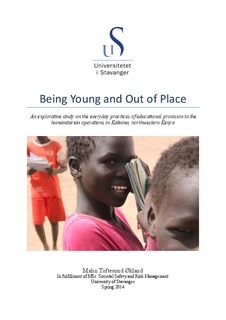| dc.contributor.author | Økland, Malin Toftesund | |
| dc.date.accessioned | 2014-09-24T08:39:33Z | |
| dc.date.available | 2014-09-24T08:39:33Z | |
| dc.date.issued | 2014-06-30 | |
| dc.identifier.uri | http://hdl.handle.net/11250/221388 | |
| dc.description | Master's thesis in Risk management and societal safety | nb_NO |
| dc.description.abstract | The scope, scale, and duration of contemporary complex emergencies have given rise to a new humanitarian paradigm in which the deontological principles of traditional humanitarianism have been challenged, and the dichotomy between relief and the protection of human rights revisited. Within this ‘new’ humanitarianism, Education in Emergencies (EiE) has surfaced as a field of practice, policy and principle. It is increasingly becoming recognized among policy makers, UN communities, and INGO practitioners that education accomplishes both life-sustaining and life-saving protection objectives in humanitarian operations, and has therefore rightfully earned its place as the fourth ‘pillar’ of humanitarian assistance.
This thesis is an explorative study into the everyday practices of providing education for refugee children in the humanitarian operations in Kakuma Refugee Camp, northwestern Kenya. Research is based on fieldwork conducted in Nairobi and Kakuma Refugee Camp from late January to early March 2014. Empirical data has been collected from various INGOs with an education mandate in the camp. The study has sought to address how EiE activities in the camp are designed and implemented in order to meet the benchmarks of ‘do no harm’ in humanitarian aid. Using normative theoretical perspectives related to crisis management, bottom-up implementation of humanitarian aid and cognizant approaches to the unintentional side-affects outside assistance may have, the thesis discusses how EiE programs are adapted to the contextual setting of Kakuma, and how community-involvement underpins the practical unfolding of education as a component of the humanitarian response.
Key findings from the study suggest that the extent to which EiE programs are responsive to the protection needs of refugee children is compromised by the resource-based reality of a rights-based approach to education. Access to education is limited and uneven, and too many children find themselves out of the protective structures that EiE is argued to provide. Findings also illuminate that community-participation is unevenly dispersed throughout the program cycle: active involvement in implementation, but nominal participation in decision-making processes and program design. Consequently, the voices of those with closest relational proximity to children’s needs have a tendency of remaining unheard if they do not conform to pre-determined operational priorities. | nb_NO |
| dc.language.iso | eng | nb_NO |
| dc.publisher | University of Stavanger, Norway | nb_NO |
| dc.relation.ispartofseries | Masteroppgave/UIS-SV-IMKS/2014; | |
| dc.rights | Attribution 3.0 Norway | * |
| dc.rights.uri | http://creativecommons.org/licenses/by/3.0/no/ | * |
| dc.subject | samfunnssikkerhet | nb_NO |
| dc.subject | education | nb_NO |
| dc.subject | protection | nb_NO |
| dc.subject | children | nb_NO |
| dc.subject | protracted complex emergencies | nb_NO |
| dc.subject | Kakuma Refugee Camp | nb_NO |
| dc.subject | UNHCR | nb_NO |
| dc.subject | INGOs | nb_NO |
| dc.subject | humanitarian aid | nb_NO |
| dc.subject | 'do no harm' | nb_NO |
| dc.subject | community-based participation | nb_NO |
| dc.subject | contextual-adaptability | nb_NO |
| dc.subject | risk management | nb_NO |
| dc.subject | Kenya | nb_NO |
| dc.title | Being young and out of place: an explorative study on the everyday practices of educational provision in the humanitarian operations in Kakuma, northwestern Kenya | nb_NO |
| dc.type | Master thesis | nb_NO |
| dc.subject.nsi | VDP::Social science: 200 | nb_NO |

